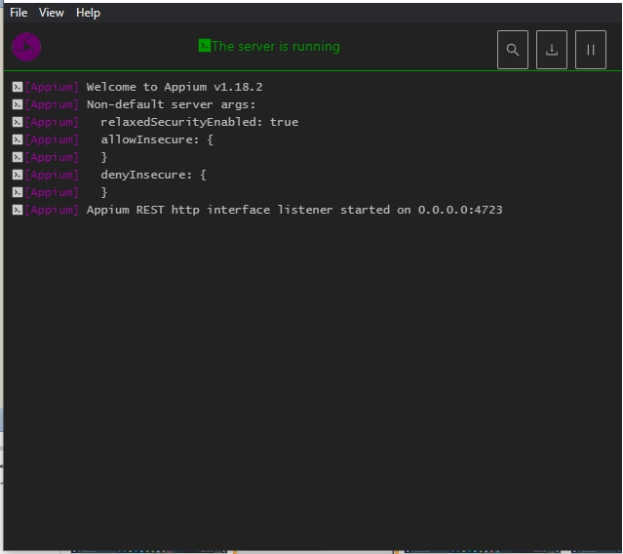

- #Appium tutorial on mac how to
- #Appium tutorial on mac install
- #Appium tutorial on mac full
- #Appium tutorial on mac code
- #Appium tutorial on mac series
Look at this example of a Hello World application available on the Applitool’s website: If you’re not yet familiar with automated visual UI testing, more broadly called Application Visual Management (or AVM for short). Running your first mobile visual UI test.Preparing your test automation environment.

#Appium tutorial on mac how to
In this tutorial, you will learn how to integrate automated visual user interface tests into a development toolchain that includes Xcode iOS simulator using Xamarin, Appium, Applitools, and MacOS (formerly OSX). In her spare time, she enjoys basketball - both playing (shooting guard) and watching (go Dubs!). She is a veteran of the Israeli air force but unfortunately, they only let her touch Oracle ERP and not an F-35 joystick.
#Appium tutorial on mac full
Previously, Sophie was a software developer at Matrix Israel where, among other things, she did full stack development using JavaScript and. Then the final one will be "Then Task added successfully".This is a guest post from Sophie Tagar, a customer support engineer at Applitools. Then we will add a new "Given Enter TaskName", and "Given Enter TaskDesc" and then "Given Click Save". We will try to simulate our test script and then try to convert it to a feature file. Then I will add the "Scenario", and here I have "Scenario" or "Scenario Outline" if I am using the data table or scenario template, but in this case, I will use "Scenario" and for example, I will add "The user can add new task" and then add "Given Click Add new Task". I will add the feature name - for example, "Create New Task". I can start with writing "Feature" and I have auto-complete because I have already installed the Gherkin and the Cucumber plugin on IntelliJ. Then we will take the BDD template and now we can start writing our feature.


Then, right-click on features and we will create a new file and the file will be CreateTask.feature. Then we will add resources and inside this one, we will create a new directory features. Under the test folder, we will create a resources directory, like the one that is inside the main folder - so right-click on the test folder, and then click "Directory". Now we can start creating our first feature.Īfter we prepared our IntelliJ IDE by installing the plug-ins and adding our required dependencies and our pom.xml file, now it's time to create our feature file.
#Appium tutorial on mac install
So here it's already installed also, but in your case, if it's not installed, we need to click install and restart your IDE. The second one is for Gherkins to be able to write feature files with auto-complete syntax. One more thing that we need to add is the plug-ins in our IntelliJ.įrom the preferences, we can search for Plugins, and here we can search for Cucumber for Java, which is already installed, but in your case, if it's not installed, you need to install it and restart your IntelliJ to take effect. In our case, we are using testng because we added cucumber for testng. We can get these from the MVN repository - we can search for it and under io.cucumber, you can find all the dependencies here.įor example, if you are using Spring or if you are using Guice, you can find your required one. I just to add our required dependencies for Cucumber and for BDD, which are the cucumber-java, cucumber-core, gherkin, and cucumber-testing. Here we have apps, data, PageObjects, and the test cases. So this is our project - I created a new project with Appium BDD and this is a similar structure from the previous one, with the data-driven. In this demo, we will prepare our project for BDD, or behavior-driven development, with Appium by installing the required plugins in our IntelliJ IDE and by adding the required dependencies in our pom.xml file.
#Appium tutorial on mac code
Once development is underway, the developers and QA will start writing step** definitions**, which are essential snippets of code that bind the scenarios from the feature files to the test code, which execute actions against the application under tests. In Cucumber, these files are called feature files, which are reviewed by a scrum team to get a clear understanding of the requirements, before starting the actual development. Then, using Gherkin language in a Given-When-Then format, the customer will be able to transfer it to the feature files.
#Appium tutorial on mac series
How we can implement the cucumber step definitions using AppiumĬucumber was created to drive the behavior-driven development, or BDD, process, such that the customer can describe the requirements as a series of examples called scenarios in plain texts. How we can create the Cucumber feature files How we can prepare our project for BDD and Cucumber with Appium In the chapter, we will start using the BDD, or behavior-driven development with Cucumber and Appium. Chapter 11.2 - Configure and Run GitHub Actions with Appium


 0 kommentar(er)
0 kommentar(er)
